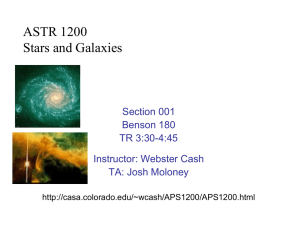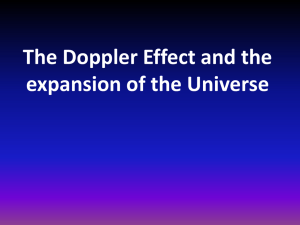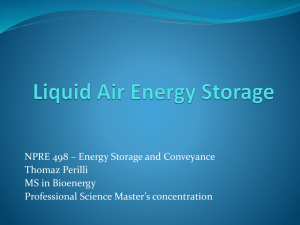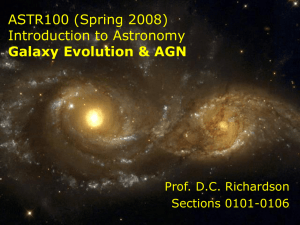The Cluster Environments of High Redshift Radio Galaxies
advertisement
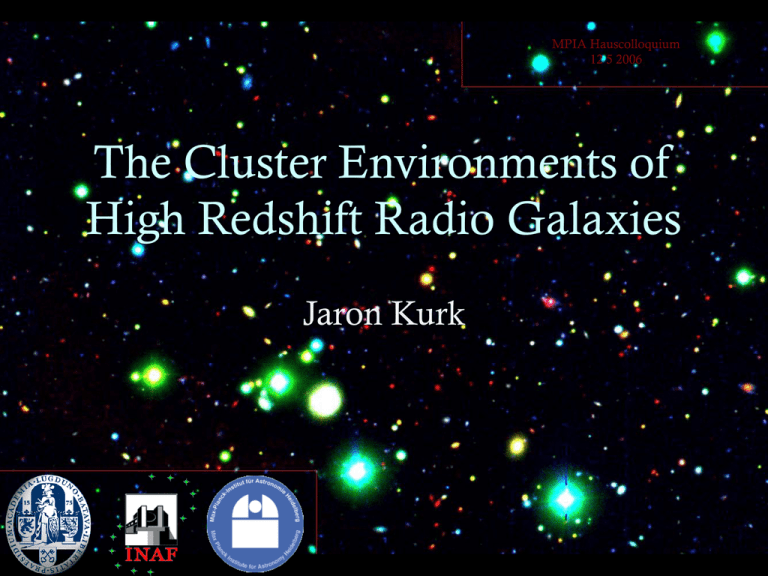
MPIA Hauscolloquium 12 5 2006 The Cluster Environments of High Redshift Radio Galaxies Jaron Kurk MPIA Hauscolloquium 12 5 2006 Other Leiden PhDs involved: Laura Pentericci Carlos De Breuck Michiel Reuland Leiden students and postdocs: Andrew Zirm Huib Intema Prof George Miley Others: Chris Carilli, Wil van Breugel, Adam Stanford Steve Croft G. De Lucia T. Heckman H. Ford P. McCarthy Dr Huub Röttgering JK PhD May 2003 Leiden HzRG Cluster Program Bram Venemans PhD April 2005 Roderik Overzier PhD May 2006 Thesis defense: May 30 Outline of Talk • Introduction – Clusters – HzRGs – HzRG-Cluster Program • Some examples – 1138 at z = 2.2 – 1338 at z = 4.1 • Program Results – Line emitters – Distant clusters Importance of Distant Clusters Distant clusters are of interest because • their presence constrains cosmological parameters (e.g. Eke et al. 1996) • their galaxies provide unique reservoir to investigate galaxy evolution – clusters at z ~ 0.5 contain more blue galaxies (Butcher & Oemler 1984) – scatter in colour-magnitude relation constrains formation mode – central brightest cluster galaxies do not fit on LF But difficult to find because of • • contamination by foreground galaxies cosmological surface brightness dimming of extended X-ray emission Most distant clusters found to date • • at z = 1.11 by X-rays (Stanford et al. 2002) at z = 1.26 by X-rays and NIR imaging (Rosati et al. 1999, Stanford et al. 1997) Properties of HzRGs Indirect evidence that HzRGs are located in (forming) clusters • Radio galaxies observed in clusters or over-densities of galaxies – Half of powerful RGs at z ~ 0.5 inhabit rich clusters (Hill & Lilly 1991, Yates et al. 1989), strong correlation with redshift as at z < 0.15 RGs avoid clusters (Prestage & Peacock 1989) – Nearby example of Cygnus A (Owen et al. 1997) – Over-density of K band galaxies in 3CR fields (Best 2000, 2003) and other z ~ 1 RG and QSO fields (Hall et al. 2001, Barr et al. 2004) – Over-density of EROs and sub-mm galaxies near 4C41.17 (Ivison et al. 2000) • Radio galaxies observed in dense ambient gas – High (> 1000 rad m-1) radio RMs (Carilli et al. 1997, Pentericci et al. 2000) • Hosts of HzRGs resemble brightest cluster galaxies • HzRGs are amongst the most massive galaxies up to z ~ 5 (De Breuck et al. 2002) Properties of HzRGs HzRGs are amongst the most massive galaxies up to z ~ 5 K-z diagram Powerful AGN massive black hole massive galaxy (Magorrian relation) De Breuck et al. (2002) Example HzRG: 1138-262 at z = 2.2 ACS/HST 20 orbits g+i 100 kpc • Elements of both hierarchical and monolithic formation • Morphological types that dominate the faint population in the UDF (chains, tadpoles and clump-clusters) • Star formation in two modes: LBG-like (50%) and diffuse (50%) Pentericci et al. (2002), Kurk (2003), Miley et al. (in prep.) Example HzRGs: emission line halos 1338 at z = 4.1 VLT line emission ACS continuum Zirm et al. (2005) 1138 at z = 2.2 VLT line emission Radio 8 GHz continuum Kurk (2003) The Leiden HzRG Cluster Program • Use HzRGs as beacons of forming clusters – HzRGs have properties of forming BCGs – Seem to live in dense environments at z ~ 1 – Most massive galaxies at any z and therefore found in most massive DM halos • Use Ly emitting galaxies as tracers of galaxy overdensities – Strongest (intrinsic) emission line – LAEs occupy faintest accesible part of LF – Spectroscopic confirmation relatively easy • VLT Large Program – Eight radio galaxy fields at 2.2 < z < 5.2 – Twenty nights with FORS/VLT (and twenty hours LRIS/Keck) – Narrow band imaging of 33 Mpc2 fields and MOS spectroscopy Line emitting galaxies at high redshift • Primordial galaxies should emit 3-6% of their bol. lum. in Ly, resulting in EW0 = 100-200 Å (Charlot & Fall 1993) • Ly is resonant, so large extinction can occur: only 25% of LBGs have EW0 > 20 Å (Shapley et al. 2003) • LAE surveys fashionable – Hu et al. (1998), Rhoads et al. (2000), Stiavelli et al. (2001), Ouchi et al. (2002), Hu et al. (2004), Tapken et al. (2006), Steidel et al. (2000) – Little evolution of UV continuum with z – Controversy about red colours and high equivalent widths – Clustering observed in large fields • LAEs are currently redshift record holders Intermezzo I - LAE at z = 6.5 • FORS2/VLT slitless spectroscopy combined with a medium band filter • One LAE emitter found at z = 6.518 with flux of 210-17 erg s-1 cm-2 • Comparison of LFs at z = 5.7 and z = 6.5 shows little evolution and therefore reionization earlier than z = 6.5 (Malhotra & Rhoads 2004) Kurk et al. (2004) The NB Imaging Technique Kurk (2003) Individual HzRG Fields • PKS 1138-262 at z = 2.16 – – – – – – Pilot VLT project (first VLT visitor observations, in 1999) Lowest redshift of sample Indications of dense environment Suitable redshift for H narrow band imaging Chandra X-ray , NICMOS, MOIRCS observations Main subject of my thesis my favourite object! • TN J1338-1942 at z = 4.10 – One of the brightest (in Ly line and radio continuum) – Most overdense field (in terms of LAEs) – Drop-out imaging with ACS and Suprime-Cam 1138 Imaging Imaging: 0.5 hr B band, 4 hr narrow band - Fifty LAEs with EW0 > 20 A and F > 210-19 erg s-1 cm-2 A-1 Spectroscopy: 6, 5.5, 4 hr for each FORS1 mask - Fifteen confirmed (out of 27) Kurk et al. (2000) 1138 Spectroscopy results Spectroscopic confirmation of 15 LAEs - Single line rules out [OII], [OIII], Hβ - One QSO: FWHM ~ 5800 km s-1, CIV emission Pentericci et al. (2000) 1138 Spectroscopy results Spectroscopic confirmation of 15 LAEs - LAE redshifts centered on radio galaxy - Probability redshifts drawn from random distr. < 0.4% - Redshifts seem to be distributed in two groups Monte Carlo Simulation Kurk et al. (2004) σv = 385, 205 km s-1 σv = 900 km s-1 2 3 Actual redshift distribution 1138 H imaging • Two 2.5’2.5’ ISAAC fields – HAEs have 5 higher density within 0.66’ radius compared with outside 1.0’ radius – No blank field HAE surveys deep enough to compare with Kurk et al. (2004) - 1138 H spectroscopy Two nights of ISAAC spectroscopy confirmed redshifts nine HAEs, including one QSO, v = 360 km s-1 Kurk et al. (2004) - Intermezzo II - Wide field H survey • • • • • Finally NIR detectors with large FoV available WFCAM survey at z = 2.2 of 1.5 deg2 (on-going, P.I. Smail) VISTA survey at z = 0.8 of 1.6 deg2 (proposed, P.I. Fynbo) LF of H emitting galaxies, good estimate of (global) SFR at z > 2 Comparison with HzRG fields (also other emission lines) 1138 X-ray sources • Chandra imaging (40 ksec) reveals – apart from RG 17 serendipitous sources in FORS field – about 50% more soft sources with flux > 10-15 erg s-1 cm-2 than in CDF (1.5 significance) – coincidence with 3 LAEs, 1 HAE, 1 ERO – optical/X-ray ratios indicate AGN – four X-ray sources and RG roughly aligned Pentericci et al. (2002), Croft et al. (2005) - 1138 SCUBA companions Field of 1138 is second densest in sample of seven HzRG fields (Stevens et al. 2003) with three companions, two of them aligned E-W 1138 NICMOS CMD Factor nine overdensity in red sequence galaxies (1.3 < JH < 2.1) in six NICMOS fields near 1138 Zirm et al. (in preparation) RG Lya Ha UDF/HDFN 1138 Subaru CMD Red sequence galaxies (J-K > 2.3) in 4’7’ MOIRCS field (Kodama et al., in prep.) Subaru NIR MOS and VLT optical MOS proposed Red sequence Lya Ha (Vega) 1338 ACS imaging ACS/HST FoV 3.4’3.4’ gri imaging to detect g-dropouts at z ~ 4 Compare with cloned GOODS B-dropouts Factor 2.5 more g-dropouts than expected, representing a 3 excess (i < 26) More than 50% within 1 Mpc radius Even stronger at i < 27 Alternative of a cluster of z ~ 0.5 Balmer break objects improbable RG - LAE - LAE - LAE - Miley et al. (2004) - g (4 orbits) - r (4 orbits) i (5 orbits) 1338 Subaru imaging Suprime-Cam FoV 25’24’ BRI imaging to detect LBGs at 3.5 < z < 4.5 (6% cont.) 874 LBGs with IAB < 26.5 125 LBGs with IAB < 25.0 Correl length r0 = 3.7 / 4.6 h-1 Mpc Largest overdensity at pos of 1338 Size of ~ 2 Mpc includes 104 LBGs 7 coincide with confirmed LAEs 28-35 LBGs associated with RG Overdensity 5-7 Spectroscopy needed to trace web Intema et al. (submitted) - Conclusions on Ly Emitters • In total ~ 300 LAEs of which ~ 150 confirmed – spectroscopic confimation succes rate ~ 90% – AGN fraction < 10%, based on line widths (95% < 1000 km s-1) • lines asymmetric, sometimes with absorption (M(HI) up to 5104 M) – LLy < 1043 erg s-1, fainter than L* in UV continuum – No evidence for zero metallicity (max EW0 < 240 A) Conclusions on Ly Emitters – Continuum colours are blueer ( = -1.7) than for LBGs ( = -1.1) – SFRs in the range 1 - 10 M yr-1 (LBGs typically > 10 M yr-1) – Low dust content (blue UV and consistent Ly and UV SFR) • extinction correction on Ly SFR << 2 – Ages < 100 Myr, in 16% < 10 Myr (from UV continuum) – Half light radii (~ 1.0 kpc) smaller than for LBGs in GOODS (~ 2.3 kpc, Ferguson et al. 2004) Venemans et al. (in prep) Large Program Results Name of RG MRC 2048-272 MRC 1138-262 MRC 0052-241 MRC 0943-242 MRC 0316-257 TN J2009-3040 TN J1338-1942 TN J0924-2201 z 2.06 2.16 2.86 2.92 3.13 3.15 4.10 5.19 IMG SPC σv (km/s) N/A 10 3 ~900 37 15 ~980 57 37 ~715 65 28 77 31 ~640 21 11 ~515 54 37 ~265 14 6 ~305 Conclusions on Distant Clusters • At least six out of eight fields show overdensity – surface overdensity on the order of 3-5 • Confirmed emitters are clustered in redshift space – width of vel. distr. 2-5 smaller than NB • Estimated protocluster masses 2-91014 M – assuming bias parameter b = 3-6 and certain volume V (Steidel et al. 1999) M = <>V(1+m), 1 + bm = C(1+gal), C = 1 + f - f (1 + m)1/3 where <> is mean density of universe and C redshift space distortions • Velocity dispersion decreases with redshift • FoV too small to give reliable estimate of sizes – but from second field near 1338 radius of ~ 2 Mpc seems correct Venemans et al. (in prep.) Conclusions on Distant Clusters N-body modelling by G. De Lucia shows that – LAEs in protoclusters can be identified with young (< 100 Myr) galaxies • luminosity or colour is not enough – velocity distribution of simulated clusters increases with decreasing redshift – HAEs near 1138 lie within virialized core and may be older (as suggested by their brighter K-band continua) Millenium simulation will improve results Venemans et al. (in prep.) RG proto-clusters Subgroups Simulated clusters Hubble Flow Conclusions on Distant Clusters Theory of linear spherical collapse predicts critical density at which structure will collapse, almost indendent of cosmology L = 1.686 (Peacock 1999) Compare evolution of linear matter overdensity of protoclusters with this critical density 1138 0316 gal M L L(z) in CDM (Carroll et al. 1992) 1338 collapses at z ~ 0.5 1138, 0316, 0924 at z ~ 0 Overzier et al. (in prep.) 0924 1338 Intermezzo III - a QSO field at z = 6.3 • Overdensity of i-dropout galaxies in the field of QSO SDSS 1030+0524 at z = 6.28 (Pentericci et al., submitted) • Follow-up spectroscopy (on-going, P.I. Walter) EROs: extremely red LAEs: purple Empty slide RG PKS 1138-262 BIK FORS/ISAAC Abbreviations used • • • • • • • HzRGs: High Redshift Radio Galaxies LAEs: Ly Emitters (Lyman- emitting galaxies) HAEs: H Emitters EROs: Extremely Red Objects ERGs: Extremely Red Galaxies (red distant galaxies) DRGs: Distant Red Galaxies (really red distant galaxies) LBGs: Lyman Break Galaxies (blue distant galaxies)


